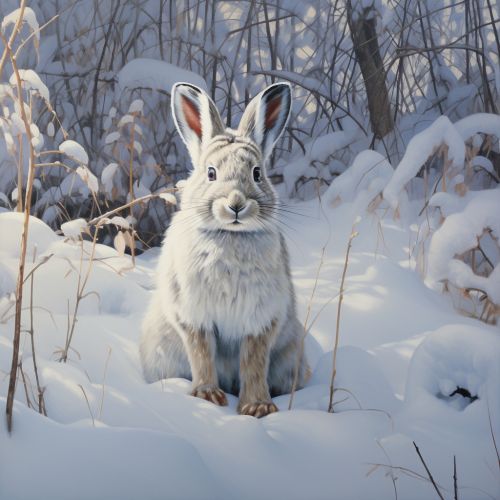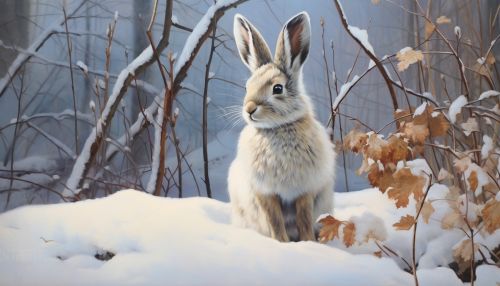Snowshoe hare
Taxonomy and Evolution
The Snowshoe Hare (Lepus americanus) is a species of hare found in North America. It is one of the many species in the genus Lepus, which includes hares and jackrabbits. The Snowshoe Hare is closely related to the Mountain Hare (Lepus timidus), but it has adapted to different environmental conditions.


Description
The Snowshoe Hare is named for its large hind feet, which are adapted for moving efficiently through snow. These feet are densely covered with fur, which provides insulation and increases the surface area in contact with the snow, reducing sinking. The hare's fur changes color seasonally, from brown or grey in the summer to white in the winter, providing excellent camouflage against predators.
Distribution and Habitat
Snowshoe Hares are widely distributed across North America, from the northern limits of the tree line in Canada and Alaska, south to the mountains of the western United States and the Appalachian Mountains. They inhabit a variety of forest habitats, including boreal and deciduous forests, and are particularly associated with areas of thick undergrowth.
Behavior and Ecology
Snowshoe Hares are primarily nocturnal and are most active during the hours of dusk and dawn. They are solitary animals, although they may form loose aggregations in areas of high population density. Their diet consists mainly of grasses and small leafy plants during the summer months, and twigs, bark, and buds in the winter.
Reproduction
The breeding season for Snowshoe Hares typically begins in late December and continues through July. Females can have between 1 to 4 litters per year, with each litter consisting of 1 to 8 young. The gestation period is approximately 36 days, and the young are born fully furred and with their eyes open, a characteristic of hares known as being precocial.
Predation and Survival
Predation is a significant selective force in Snowshoe Hare populations. Their primary predators include the Lynx, Coyote, and Great Horned Owl. To evade these predators, Snowshoe Hares rely on their excellent camouflage and their ability to run at high speeds.
Role in Ecosystem
Snowshoe Hares play a crucial role in their ecosystem. They are a primary food source for many predators, and their population cycles can significantly impact predator populations, particularly the Lynx. They also influence vegetation patterns through their foraging activities.
Conservation Status
The Snowshoe Hare is currently listed as a species of least concern by the International Union for Conservation of Nature (IUCN) due to its wide distribution and presumed large population. However, changes in forest management practices and climate change pose potential threats to Snowshoe Hare populations.
